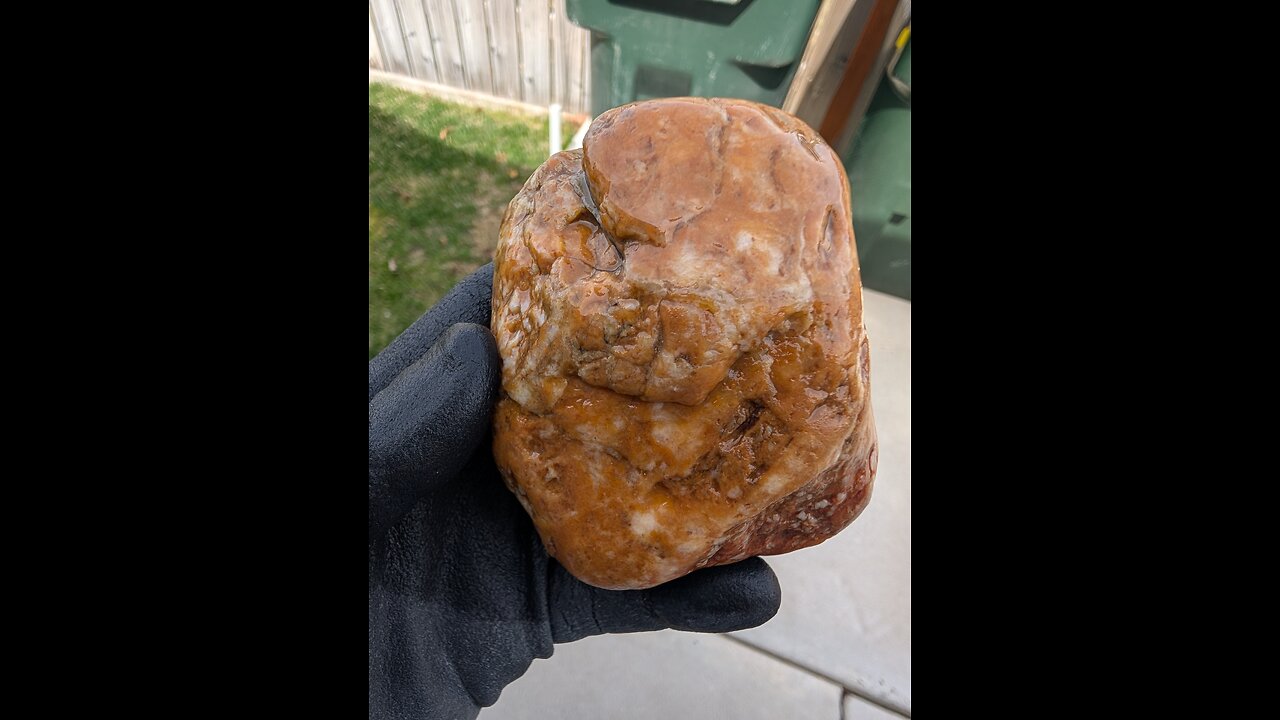Premium Only Content

The rock in the image appears to be a type of agate, likely a variety known as carnelian agate or a similar chalcedony-based stone. Here's why:
Color and Appearance: The rock has a translucent to semi-translucent quality with a mix of warm orange, brown, and white hues. Carnelian, a type of chalcedony, often exhibits these colors, ranging from pale orange to deep reddish-brown. The white patches could be due to inclusions or banding, which is common in agates.
Texture and Luster: It looks smooth and has a waxy to glassy luster, typical of chalcedony minerals like agate. The surface appears polished, either naturally or by human intervention, which is common for agates used in jewelry or collections.
Banding: Agates often have concentric banding or layering, and while the banding isn’t extremely pronounced in this specimen, the variations in color suggest some layering, which is a hallmark of agate formation.
What is Agate/Chalcedony?
Agate is a variety of chalcedony, which itself is a microcrystalline form of quartz (SiO₂). It forms in volcanic or sedimentary environments, often in cavities or voids where silica-rich fluids deposit layers over time, creating the characteristic banding. Carnelian specifically is valued for its warm tones and is often associated with iron oxide impurities that give it the orange-to-red coloration.
Other Possibilities
While carnelian agate is a strong candidate, there are a couple of other possibilities:
Jasper: Jasper is another form of chalcedony but is typically more opaque and lacks the translucency seen here. However, some jasper varieties can have similar colors.
Marble or Calcite: Some types of marble or calcite can have a similar appearance, especially with orange and white coloring, but they usually lack the waxy luster and translucency of chalcedony. Calcite also tends to be softer (Mohs hardness of 3) compared to chalcedony (Mohs hardness of 6.5–7).
How to Confirm
To be more certain, you could:
Hardness Test: Chalcedony has a Mohs hardness of 6.5–7, so it should scratch glass but not be scratched by a steel knife.
Translucency Test: Hold it up to a light source. Agates often show some translucency, especially in thinner sections.
Streak Test: Chalcedony typically leaves a white streak when scratched on an unglazed ceramic tile.
-
 6:30
6:30
The Shannon Joy Show
12 hours agoMTG DIVORCES Herself From Trump & the MAGA Movement
4399 -
 LIVE
LIVE
The Bubba Army
21 hours agoJELLY ROLL'S WIFE GOING TO JAIL! - Bubba the Love Sponge® Show | 11/26/25
2,249 watching -
 14:17
14:17
Actual Justice Warrior
14 hours agoBlack Man CRIES Victim After Welfare Gets Cut
11.5K18 -
 23:51
23:51
Code Blue Cam
21 hours agoDrunk Man Goes to War on Cops After Being Denied More Alcohol
11.8K17 -
 1:03:23
1:03:23
Coin Stories with Natalie Brunell
18 hours agoFinding the Next 100x Investment with Eric Jackson
11.8K3 -
 15:54
15:54
MetatronGaming
2 days agoChronicles Medieval trailer reaction METATRON
4.33K4 -
 1:53:27
1:53:27
Camhigby
15 hours ago $7.03 earned72 ARRESTS: Chicago Train Attack Is Worse Than Anyone Knows
13.2K6 -
 23:10
23:10
DeVory Darkins
1 day agoBondi issues chilling warning to comey after shocking twist emerges
24.5K76 -
 8:01
8:01
MattMorseTV
11 hours ago $33.55 earnedVance has finally HAD ENOUGH.
62.9K105 -
 15:18
15:18
MetatronHistory
2 days agoThe REAL Origins of the SUMERIANS
13.4K3